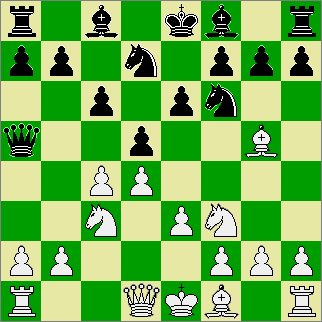

This line arises in the Queen's Gambit Declined after the moves...

The Cambridge Springs Defense is discussed in this Wikipedia article.
The origins of the Cambridge Springs Defense were discussed in Tim Harding's January 14, 2004 The Kibitzer article at ChessCafe.com but this site is no longer active. The article may be archived but currently I have not found it.
The The Oxford Companion to Chess says this variation was introduced by Lasker in a game against Hodges in 1892. This opening variation became known as the Cambridge Springs Defense because it was employed in several games in the 1904 tournament. Specifically, they are: Marshall-Teichmann, Hodges-Barry and Schlechter-Teichmann. In these three games, Black was only able to achieve one draw (no wins). Despite this unimpressive outcome, the variation carries the name Cambridge Springs Defense to this day. Another game which appears to be similar to the Cambridge Springs variation is Pillsbury-Marco, in which Black employs ...Be7 and only plays ...Nbd7 a few moves later. ChessBase 7.0 gives this game a D53 ECO classification.
In Chess Openings: Theory and Practice Horowitz writes, "The great American master, Harry Nelson Pillsbury, introduced it at Nuremberg in 1896. Hence it is also known as the Pillsbury Defense. It was only after the Cambridge Springs tournament of 1904, however, that the defense made an impression. Pillsbury's idea is based on counterattack: Black pins White's Queen Knight and can increase the pressure with [...Ne4 and ...Bb4]. White must also take into consideration the attack on his Queen Bishop on [g5] after [dxc4]. Although in most cases Black enjoys excellent counterplay the defense is little used today for no discernible reason other than the dictates of fashion." This is actually incorrect. This variation was not played by Pillsbury in Nuremberg 1896. However, one researcher has advised me that Pillsbury was a student of the openings and was a great contributor to the Cambridge Springs Defense body of theory.
For an example of the Cambridge Springs Defense played at the highest levels, see Capablanca-Alekhine, Buenos Aires, 1927 (World Championship Match).The Encyclopedia of Chess Openings (ECO) classifies this opening under D52. Here are the major variations:
Cambridge Springs Defense
1.d4 d5 2.c4 e6 3.Nc3 Nf6 4.Bg5 Nbd7 5.e3 c6 6.Nf3
Cambridge Springs Defense, Proper
1.d4 d5 2.c4 e6 3.Nc3 Nf6 4.Bg5 Nbd7 5.e3 c6 6.Nf3 Qa5
Cambridge Springs Defense, Bogoljubow Variation
1.d4 d5 2.c4 e6 3.Nc3 Nf6 4.Bg5 Nbd7 5.e3 c6 6.Nf3 Qa5 7.Nd2 Bb4 8.Qc2
Cambridge Springs Defense, Argentine Variation
1.d4 d5 2.c4 e6 3.Nc3 Nf6 4.Bg5 Nbd7 5.e3 c6 6.Nf3 Qa5 7.Nd2 Bb4 8.Qc2 O-O 9.Bh4
Cambridge Springs Defense, Rubinstein Variation
1.d4 d5 2.c4 e6 3.Nc3 Nf6 4.Bg5 Nbd7 5.e3 c6 6.Nf3 Qa5 7.Nd2 dxc4
Cambridge Springs Defense, Capablanca Variation
1.d4 d5 2.c4 e6 3.Nc3 Nf6 4.Bg5 Nbd7 5.e3 c6 6.Nf3 Qa5 7.Bxf6
Cambridge Springs Defense, with 7.cxd5 [Exchange Variation]
1.d4 d5 2.c4 e6 3.Nc3 Nf6 4.Bg5 Nbd7 5.e3 c6 6.Nf3 Qa5 7.cxd5
Cambridge Springs Defense, Yugoslav Variation
1.d4 d5 2.c4 e6 3.Nc3 Nf6 4.Bg5 Nbd7 5.e3 c6 6.Nf3 Qa5 7.cxd5 Nxd5
Source: CompuServe Chess Forum